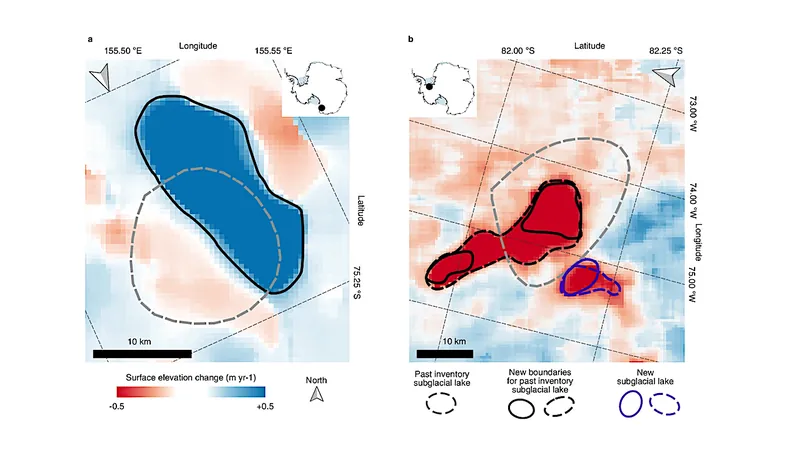
Massive Discovery: 85 New Subglacial Lakes Uncovered Beneath Antarctica!
2025-09-19
Author: Yu
A Hidden World Beneath the Ice
Beneath the vast expanse of ice that envelops Antarctica lies a hidden network of subglacial lakes, crucial to understanding the stability of glaciers and their impact on global sea levels. Recent research has unveiled the existence of 85 new, previously unknown lakes, drastically boosting the count of active subglacial lakes in Antarctica to a staggering 231.
How Did This Major Find Happen?
Thanks to a decade's worth of data gathered from the European Space Agency's CryoSat satellite, scientists have made groundbreaking discoveries beneath the icy surface. Published in *Nature Communications*, this new research reveals not just the lakes, but also the intricate drainage pathways beneath the ice, including five interconnected lake networks.
Eyes in the Sky: The Role of CryoSat
The CryoSat satellite has been pivotal in this research since its launch in 2010, using radar altimetry to measure the thickness of polar ice and monitor ice sheet changes in Antarctica and Greenland. The spacecraft's observations reveal the dynamic behavior of ice surfaces, which fluctuate due to the filling and draining of these hidden lakes.
Groundbreaking Observations
Sally Wilson, the lead author from the University of Leeds, highlighted the challenges in monitoring these underwater phenomena due to the heavy ice cover. Before this study, only 36 complete cycles of subglacial lake filling and draining had been documented globally. Remarkably, this research adds 12 more cycles, bringing the total to 48.
Unlocking Secrets of Ice Dynamics
Professor Anna Hogg, a co-author of the study, emphasized that these findings indicate a more dynamic subglacial environment than previously believed. With enhanced knowledge of water flow beneath the ice, researchers can better understand how these systems impact the surrounding ocean and influence overall ice sheet stability.
Subglacial Lakes: More Than Just Water
Subglacial lakes form as a result of geothermal heat and the pressure from overlying ice. They can either remain stable or actively fill and drain, which, in turn, affects ice movement. The largest known lake, Lake Vostok, lies beneath a staggering 4 kilometers of ice, holding enough water to fill the Grand Canyon as it teeters on the brink of stability.
The Bigger Picture: Climate Modeling Implications
Understanding these subglacial dynamics is crucial for accurate climate modeling. Sally pointed out that hydrology beneath the ice sheets is often overlooked in projections of sea-level rise. By mapping the locations and behaviors of these lakes, scientists can significantly enhance their models and prepare for future climate scenarios.
Conclusion: A Call for Continued Research
As scientists unveil these hidden lakes and the mysteries they hold, the necessity for continued monitoring and research becomes ever clearer. Unraveling the complex interactions between lakes, ice sheets, and the underlying bedrock may ultimately help to predict how quickly our oceans will rise in response to a warming planet.

 Brasil (PT)
Brasil (PT)
 Canada (EN)
Canada (EN)
 Chile (ES)
Chile (ES)
 Česko (CS)
Česko (CS)
 대한민국 (KO)
대한민국 (KO)
 España (ES)
España (ES)
 France (FR)
France (FR)
 Hong Kong (EN)
Hong Kong (EN)
 Italia (IT)
Italia (IT)
 日本 (JA)
日本 (JA)
 Magyarország (HU)
Magyarország (HU)
 Norge (NO)
Norge (NO)
 Polska (PL)
Polska (PL)
 Schweiz (DE)
Schweiz (DE)
 Singapore (EN)
Singapore (EN)
 Sverige (SV)
Sverige (SV)
 Suomi (FI)
Suomi (FI)
 Türkiye (TR)
Türkiye (TR)
 الإمارات العربية المتحدة (AR)
الإمارات العربية المتحدة (AR)